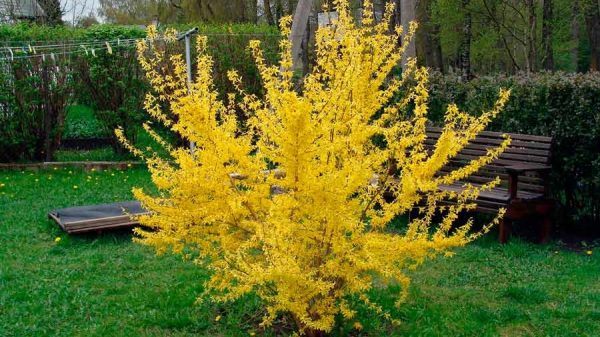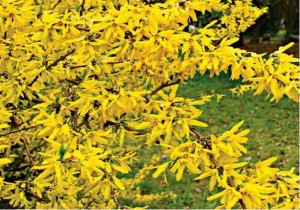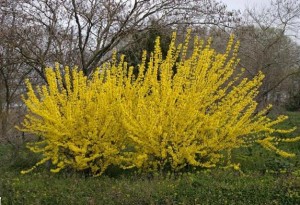Back in April, when the buds of most plants are just beginning to swell, forsythia is already blooming its golden-yellow bells. They thickly cover graceful drooping branches that do not yet have leaves. Leaves begin to appear when flowering is over.
At this time, not a single shrub can compete with forsythia in beauty. For such an abundance of bright, yellow colors, the flowering of this plant is often called golden.
Forsythia is light-loving, drought-resistant and undemanding to the soil. But not all species are winter-hardy enough. Some varieties freeze slightly in frosty winters, but as a rule they quickly recover and begin to bloom in the same year.
Forsythia propagation
This shrub reproduces quite easily. It can be propagated by root suckers, cuttings, and seeds. Many species have long shoots that hang down to the ground. If such a shoot is simply pressed to the ground, after some time it will grow roots.
Forsythia shrub in garden design
This beautiful shrub can be used in different ways in site design. It attracts attention both in single plantings and in combination. with other decorative plants. Blooming forsythia is especially beautiful on a green lawn or against a background of coniferous trees. If you cut off a branch of it in winter and place it in a vase with water, it will bloom and will delight you with its flowering despite all the frosts.
As an ornamental plant, forsythia has become widespread in Europe and America, where quite a few of its varieties have been created. In our country it is much less common. As a rule, only in parks or squares.
Forsythia shrub, types and varieties
The most famous and common types are:
Forsythia drooping. The earliest flowering species. A large shrub that grows up to 3m, with a spreading crown. Blooms in April. The flowers are golden-yellow, large (up to 3.5 cm). Prefers fertile soils. The plant's winter hardiness is high.
Forsythia is medium. The most beautiful of the forsythias. A bush about 3 m high, with a wide-spreading crown, in which some of the shoots are arched and hang down, and some are directed upward. It blooms and bears fruit from 2 to 3 years. Flowering begins at the end of April. Lasts three weeks. This is the most drought-resistant and winter-hardy species. It is best propagated by cuttings.
European forsythia. The bush grows up to 2m. in height. The diameter of the bush rarely exceeds 1.5 m. Begins to bloom in early May. Flowering lasts more than three weeks. The fruits ripen only in October. The winter hardiness of the plants is high.
Forsythia ovoid. Spreading shrub about 3.5 m high, blooming in the second half of May. The flowers are yellow, rather large, located on the shoots singly or in groups. A very winter-hardy species. Propagated by seeds and green cuttings.
Forsythia green. Bush up to 3m high, with raised green branches. The shoots are faceted. The leaves are oblong, toothed. The flowers are light yellow, with a slightly greenish tint. Sometimes in frosty winters it freezes. Can be propagated by cuttings or layering.
YOU CAN ALSO READ:




 CUCUMBERS NEVER GET SICK, I'VE BEEN USING ONLY THIS FOR 40 YEARS! I SHARE A SECRET WITH YOU, CUCUMBERS ARE LIKE THE PICTURE!
CUCUMBERS NEVER GET SICK, I'VE BEEN USING ONLY THIS FOR 40 YEARS! I SHARE A SECRET WITH YOU, CUCUMBERS ARE LIKE THE PICTURE! You can dig a bucket of potatoes from each bush.Do you think these are fairy tales? Watch the video
You can dig a bucket of potatoes from each bush.Do you think these are fairy tales? Watch the video
 How our fellow gardeners work in Korea. There is a lot to learn and just fun to watch.
How our fellow gardeners work in Korea. There is a lot to learn and just fun to watch. Eye trainer. The author claims that with daily viewing, vision is restored. They don't charge money for views.
Eye trainer. The author claims that with daily viewing, vision is restored. They don't charge money for views. A 3-ingredient cake recipe in 30 minutes is better than Napoleon. Simple and very tasty.
A 3-ingredient cake recipe in 30 minutes is better than Napoleon. Simple and very tasty. Therapeutic exercises for cervical osteochondrosis. A complete set of exercises.
Therapeutic exercises for cervical osteochondrosis. A complete set of exercises. Which indoor plants match your zodiac sign?
Which indoor plants match your zodiac sign? What about them? Excursion to German dachas.
What about them? Excursion to German dachas.